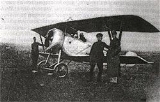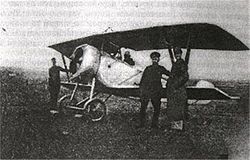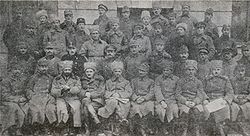
Ukrainian Galician Army
Encyclopedia
Ukrainian Galician Army , was the Ukrainian
military of the West Ukrainian National Republic
during and after the Polish-Ukrainian War
.
by the hundreds of thousands following the collapse of the Central Powers at the end of World War I
. However, the centers of Austria's military industry lay far from Galicia, and subsequent difficulty with resupply was a major factor in the Galicians losing their war against Poland.
 The government of the West Ukrainian People's Republic was well organized and was able to mobilize over 100,000 people by spring 1919, 40,000 of whom were battle-ready. Due to the Ukrainians' generally poor socioeconomic status, the army had a disporoprtionately low ratio of officers to other ranks. In the Austro-Hungarian Army
The government of the West Ukrainian People's Republic was well organized and was able to mobilize over 100,000 people by spring 1919, 40,000 of whom were battle-ready. Due to the Ukrainians' generally poor socioeconomic status, the army had a disporoprtionately low ratio of officers to other ranks. In the Austro-Hungarian Army
, ethnic Ukrainians had accounted for only two out of 1,000 officers (in comparison, Poles had made up 27/1,000 officers in the Austrian military). As a result, although most of the junior rank officers were Galicians the government of the West Ukrainian People's Republic relied largely on former high ranking officers of the defunct Russian Army, such as General Mykhailo Omelianovych-Pavlenko
, to take on the post of commander and general staff. It also staffed many positions with unemployed Austrian and German officers. For this reason, the German language was the easiest way for officers to communicate with each other and was the dominant language among the staff. Despite these measures, only approximately 2.4% of the army consisted of officers.
 The Ukrainian Galician Army reached its greatest strength in June 1919, where it had 70,000 to 75,000 men, including reserves. It had very limited cavalry but artillery, consisting of ex-Austrian pieces, was a strength. The UHA had 2-3 armored cars and two armored trains. The UHA's air force, organized by Petro Franko
The Ukrainian Galician Army reached its greatest strength in June 1919, where it had 70,000 to 75,000 men, including reserves. It had very limited cavalry but artillery, consisting of ex-Austrian pieces, was a strength. The UHA had 2-3 armored cars and two armored trains. The UHA's air force, organized by Petro Franko
(son of the poet Ivan Franko
), fielded 40 airplanes, and until April 1919 enjoyed air superiority over the Poles.
, the 1st Brigade of Sich Riflemen
became the elite force of the Ukrainian Galician Army during the war against Poland. It was formed in 1914 by former members of youth and paramilitary organizations and fought in Galicia and Ukraine against the Russian Empire throughout the first world war. At its peak this brigade had 8,600 men, not all of whom fought in Galicia.
recruited from Jewish university and high school students in Ternopil
and led by Lieutenant Solomon Leimberg. Formed in June, 1919, it attained a strength of 1,200 men and participated in combat against the Poles in July 1919 and subsequently against the Bolsheviks. The battalion was decimated by a typhus epidemic in late 1919 and its surviving soldiers were subsequently reassigned to other units within the Ukrainian Galician Army.
Territorially the West Ukrainian People's Republic was divided into three Military Oblasts centered in Lviv
, Tarnopil, and Stanyslaviv with four okrugas (districts) in each.
Ukraine
Ukraine is a country in Eastern Europe. It has an area of 603,628 km², making it the second largest contiguous country on the European continent, after Russia...
military of the West Ukrainian National Republic
West Ukrainian National Republic
The West Ukrainian People's Republic was a short-lived republic that existed in late 1918 and early 1919 in eastern Galicia, that claimed parts of Bukovina and Carpathian Ruthenia and included the cities of Lviv , Przemyśl , Kolomyia , and Stanislaviv...
during and after the Polish-Ukrainian War
Polish-Ukrainian War
The Polish–Ukrainian War of 1918 and 1919 was a conflict between the forces of the Second Polish Republic and West Ukrainian People's Republic for the control over Eastern Galicia after the dissolution of Austria-Hungary.-Background:...
.
Military equipment
The Ukrainian Galician Army obtained its arms from Austrian depots and from the demobilized Austrian and German troops who streamed through GaliciaKingdom of Galicia and Lodomeria
The Kingdom of Galicia and Lodomeria was a crownland of the Habsburg Monarchy, the Austrian Empire, and Austria–Hungary from 1772 to 1918 .This historical region in eastern Central Europe is currently divided between Poland and Ukraine...
by the hundreds of thousands following the collapse of the Central Powers at the end of World War I
World War I
World War I , which was predominantly called the World War or the Great War from its occurrence until 1939, and the First World War or World War I thereafter, was a major war centred in Europe that began on 28 July 1914 and lasted until 11 November 1918...
. However, the centers of Austria's military industry lay far from Galicia, and subsequent difficulty with resupply was a major factor in the Galicians losing their war against Poland.
Armed Forces

Austro-Hungarian Army
The Austro-Hungarian Army was the ground force of the Austro-Hungarian Dual Monarchy from 1867 to 1918. It was composed of three parts: the joint army , the Austrian Landwehr , and the Hungarian Honvédség .In the wake of fighting between the...
, ethnic Ukrainians had accounted for only two out of 1,000 officers (in comparison, Poles had made up 27/1,000 officers in the Austrian military). As a result, although most of the junior rank officers were Galicians the government of the West Ukrainian People's Republic relied largely on former high ranking officers of the defunct Russian Army, such as General Mykhailo Omelianovych-Pavlenko
Mykhailo Omelianovych-Pavlenko
Mykhailo Omelianovych-Pavlenko , December 8, 1878 - May 29, 1952, was the Supreme Commander of the Ukrainian Galician Army and of the Army of the Ukrainian National Republic...
, to take on the post of commander and general staff. It also staffed many positions with unemployed Austrian and German officers. For this reason, the German language was the easiest way for officers to communicate with each other and was the dominant language among the staff. Despite these measures, only approximately 2.4% of the army consisted of officers.

Petro Franko
Petro Ivanovych Franko son of the Ukrainian writer Ivan Franko. Petro was a Ukrainian educator, pedagogue, writer, ethnographer, scientist, military leader, and politician...
(son of the poet Ivan Franko
Ivan Franko
Ivan Yakovych Franko was a Ukrainian poet, writer, social and literary critic, journalist, interpreter, economist, political activist, doctor of philosophy, the author of the first detective novels and modern poetry in the Ukrainian language....
), fielded 40 airplanes, and until April 1919 enjoyed air superiority over the Poles.
Sich Rifles
A former unit of the Austro-Hungarian ArmyAustro-Hungarian Army
The Austro-Hungarian Army was the ground force of the Austro-Hungarian Dual Monarchy from 1867 to 1918. It was composed of three parts: the joint army , the Austrian Landwehr , and the Hungarian Honvédség .In the wake of fighting between the...
, the 1st Brigade of Sich Riflemen
Sich Riflemen
The Sich Riflemen Halych-Bukovyna Kurin were one of the first regular military units of the Army of the Ukrainian People's Republic. The unit operated from 1917 to 1919 and was formed from Ukrainian soldiers of the Austro-Hungarian army, local population and former commanders of the Ukrainian Sich...
became the elite force of the Ukrainian Galician Army during the war against Poland. It was formed in 1914 by former members of youth and paramilitary organizations and fought in Galicia and Ukraine against the Russian Empire throughout the first world war. At its peak this brigade had 8,600 men, not all of whom fought in Galicia.
Jewish Battalion
The Ukrainian Galician Army fielded a Jewish battalionBattalion
A battalion is a military unit of around 300–1,200 soldiers usually consisting of between two and seven companies and typically commanded by either a Lieutenant Colonel or a Colonel...
recruited from Jewish university and high school students in Ternopil
Ternopil
Ternopil , is a city in western Ukraine, located on the banks of the Seret River. Ternopil is one of the major cities of Western Ukraine and the historical region of Galicia...
and led by Lieutenant Solomon Leimberg. Formed in June, 1919, it attained a strength of 1,200 men and participated in combat against the Poles in July 1919 and subsequently against the Bolsheviks. The battalion was decimated by a typhus epidemic in late 1919 and its surviving soldiers were subsequently reassigned to other units within the Ukrainian Galician Army.
Structure
The Army consisted of numerous military formations which later were organized into four Corps. The Corps were farther divided into brigades composed of several regular military units.- I Corps UHA
- 5th Sokal Brigade
- 6th Rava Brigade
- 9th Uhniv-Belz Brigade
- 10th Yavoriv Brigade
- II Corps UHA
- Legion of Ukrainian Sich Riflemen
- 2nd Kolomyia Brigade
- 3rd Berezhany Brigade
- 4th Zolochiv Brigade
- III Corps UHA
- 1st Mountainous Brigade
- 7th Stryi Brigade
- 8th Sambir Brigade
- Battle groups "Krukevychi" and "Hlyboka", reformed into 11th Stryi Brigade
- 14th Brigade (later)
- IV Corps UHA
- 12th Brigade
- 21st Zbarazh Brigade
Territorially the West Ukrainian People's Republic was divided into three Military Oblasts centered in Lviv
Lviv
Lviv is a city in western Ukraine. The city is regarded as one of the main cultural centres of today's Ukraine and historically has also been a major Polish and Jewish cultural center, as Poles and Jews were the two main ethnicities of the city until the outbreak of World War II and the following...
, Tarnopil, and Stanyslaviv with four okrugas (districts) in each.
Notable Soldiers of the Ukrainian Galician Army
- Archduke Wilhelm of Austria, Austrian Archduke and Ukrainian patriot
- Petro FrankoPetro FrankoPetro Ivanovych Franko son of the Ukrainian writer Ivan Franko. Petro was a Ukrainian educator, pedagogue, writer, ethnographer, scientist, military leader, and politician...
, son of Ukrainian writer Ivan FrankoIvan FrankoIvan Yakovych Franko was a Ukrainian poet, writer, social and literary critic, journalist, interpreter, economist, political activist, doctor of philosophy, the author of the first detective novels and modern poetry in the Ukrainian language.... - Oleksander HrekovOleksander HrekovOleksander Petrovych Hrekov was a general of the Imperial Russian Army, Ukrainian People's Army, military professor and one of the most prominent personalities in the History of Ukraine...
, commander-in-chief, ethnic Russian former Tsarist general, architect of the Chortkiv offensiveChortkiv offensiveThe Chortkiv offensive , sometimes also referred to as the June Offensive, was a surprise military operation by the Ukrainian Galician Army in the Polish-Ukrainian War for Eastern Galicia.... - Yevhen KonovaletsYevhen KonovaletsYevhen Konovalets was a military commander of the UNR army and political leader of the Ukrainian nationalist movement...
, founder and first leader of the Organization of Ukrainian NationalistsOrganization of Ukrainian NationalistsThe Organization of Ukrainian Nationalists is a Ukrainian political organization which as a movement originally was created in 1929 in Western Ukraine . The OUN accepted violence as an acceptable tool in the fight against foreign and domestic enemies particularly Poland and Russia... - Mykhailo Omelianovych-PavlenkoMykhailo Omelianovych-PavlenkoMykhailo Omelianovych-Pavlenko , December 8, 1878 - May 29, 1952, was the Supreme Commander of the Ukrainian Galician Army and of the Army of the Ukrainian National Republic...
, Supreme Commander, later defence minister of the Ukrainian People's RepublicUkrainian People's RepublicThe Ukrainian People's Republic or Ukrainian National Republic was a republic that was declared in part of the territory of modern Ukraine after the Russian Revolution, eventually headed by Symon Petliura.-Revolutionary Wave:...
's government-in-exile - Hnat StefanivHnat StefanivHnat Stefaniv was a colonel of the Ukrainian Galician Army and the army of the UNR. Born in the village of Topoivtsi near Horodenka Stefaniv rose to the rank of major in the Austro-Hungarian army. In the November retreat of 1918 he was the organizor and commendant of the Zolochiv area in the...
, commander of Ukrainian forces in Lviv and later commander of the Ukrainian army in exile - Dmytro VitovskyDmytro VitovskyDmytro Vitovsky was a Ukrainian politician and military leader....
, organizer of the Ukrainian uprising in LvivBattle of Lwów (1918)Battle of Lviv begun on 1 November 1918 and lasted till May 1919 and was a six months long conflict between the forces of the West Ukrainian People's Republic and local Polish civilian population assisted later by regular Polish Army forces for the control...
and special operations formations. Later he was a member of Western Ukrainian delegation to the Paris Peace ConferenceParis Peace Conference, 1919The Paris Peace Conference was the meeting of the Allied victors following the end of World War I to set the peace terms for the defeated Central Powers following the armistices of 1918. It took place in Paris in 1919 and involved diplomats from more than 32 countries and nationalities...
in May 1919

